#(one of which is historically accurate and one of which is about the ford edsel)
Text

new management, new name.
#em draws stuff#oc time again hehe#haunted by your hand#the gambler: james webster#once again scribbling stuff that might not even pertain to the actual story that I'm also not writing yet#after kate's death james takes a bit of a turn and renaming the inn is certainly the more visible part of it#the former name was 'the horse-collar inn' which is in fact two different elaborate jokes#(one of which is historically accurate and one of which is about the ford edsel)#and then the new name is just. Very obvious wrt the location of the inn and Certain Other Things which are at the crossroads.
11 notes
·
View notes
Text
Healthy Food to Build Healthy Communities
What measures do you use to judge whether food is “healthy”? What connections do you see between healthy food and healthy communities? Today the concept of “food security” links nutritious food to individual and community health. This blog features historical resources in the collections of The Henry Ford that help us explore the meaning of “food security.” Many relate to the work of Black agricultural scientist George Washington Carver with Black farm families in and around Tuskegee, Alabama, between the 1890s and 1940s.
What Does "Food Security" Mean to You?
A big meal often symbolizes food security. You can almost smell the roast goose (once preferred to turkey) and taste the fresh apples, oranges and bananas in this centerpiece on a family’s holiday table!

Family Seated at Dining Table for a Holiday Meal, circa 1945. THF98738
But does having a big meal on special occasions mean that a person, a family, or a community is “food secure”?
The Food and Agriculture Organization of the United Nations (FAO) explains that a person is “food secure” if they have regular access to safe and nutritious food in amounts required for normal growth and development and in quantity and calories needed to maintain an active and healthy life.
Students at this South Carolina school all appear healthy. This implies that they have access to a quantity of nutritious food necessary for normal growth. It also implies that they consume it consistently which helped keep them healthy and better able to complete their schoolwork.
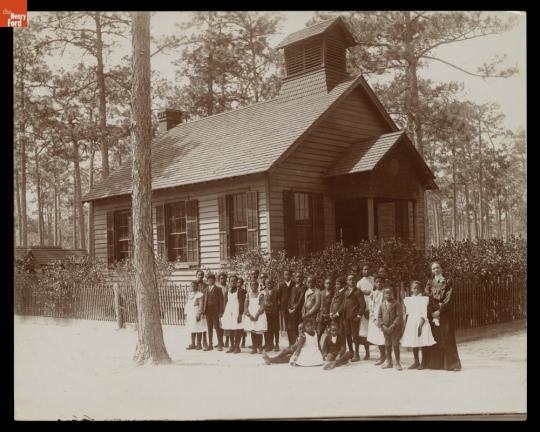
School Teacher and Her Students, Pinehurst Tea Plantation, Summerville, South Carolina, circa 1903. THF115900
Historically, many farm families raised much of the food they needed to survive, including meat, vegetables, grains, and fruit. The Mattox family farmed their own land, and they dedicated time and energy to tending their garden and raising their own beans and sweet corn (as pictured in this photograph). Being responsible for your own food supply required careful planning and hard work year-round because families had to grow, process, preserve, and then prepare and consume what they (and their livestock) ate. As long as everything went according to plan, and no disasters arose, a family might be food secure.

Mattox Family Home in Greenfield Village, 1991. THF45319
Many factors led to food insecurity. This indenture for three orphaned children, William (7 yrs old), Dennis (5 yrs old) and Henry (18 months old), specified that they receive “a sufficiency of food.” What did “sufficiency” mean? Consuming calories might provide energy to work, but calories alone did not (and do not) ensure a healthy life. Furthermore, being unfree made these indentured children dependent on someone else who might have other ideas about what “sufficiency of food” meant.
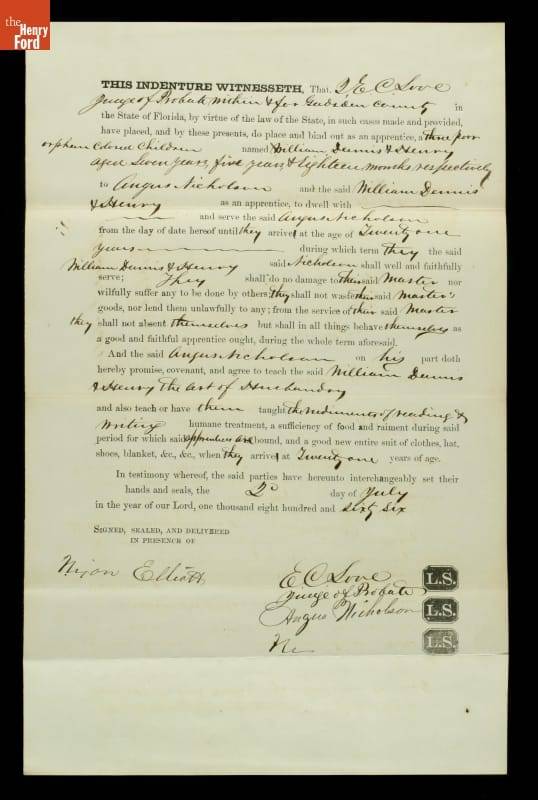
Indenture for "...Colored Children Named William, Dennis & Henry," July 20, 1866. THF8563
Cotton and Food Insecurity
Southern farm families often grew cotton as their cash crop. Farm families could not eat cotton though the seed yielded byproducts used in livestock feed, and oil that became a popular cooking ingredient. Landowners and tenant farmers could strategize how much cotton to grow, and could plant corn to feed their hogs, and could dedicate land for a garden. Yet, many families across the rural South, Black and white alike, farmed cotton, and they received a share of the crop they grew as payment for a year of labor. Owners expected these sharecroppers to focus their energy on the cash crop – cotton - and not spend valuable labor on raising their own food. Instead, families became even more economically insecure by buying inexpensive food on credit.
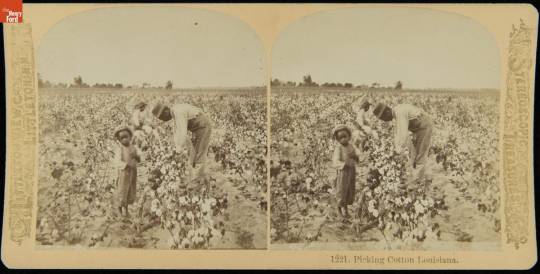
Picking Cotton, Louisiana, 1883-1900. THF278896
Many sharecroppers and agricultural laborers in the South lived on a diet of meat (pork), meal (cornmeal) and molasses (processed from either sugar cane or sorghum) – the 3M diet. While pork in its many forms (including lard sandwiches) and cornbread with molasses provided much needed calories, the 3M diet did not deliver nutrients needed to maintain health. Niacin deficiencies led to the debilitating disease, pellagra, which afflicted impoverished people across the South and beyond.

Trade Card for Silver Leaf Lard, Swift & Company, 1870-1900. THF225588
Inadequate supplies of food, and diets lacking in nutrients, undermined food security. Racism also undermined access to adequate foods. Graphic arts advertising southern staples often reinforced racist stereotypes rather than reality – that Black women often held positions of authority as Black cooks who prepared meals for others who could afford fresh foods and a varied and nutritious diet.

Advertising Poster, "Old Fashion Molasses," circa 1900. THF8044
Improving rural health required a revolution that reduced the dependency on cotton and increased the types of crops grown for market. George Washington Carver, the first Black American to hold an advanced degree in agricultural science, used his knowledge to try to convince farmers to improve soils to increase cotton yields, but to also raise additional crops such as sweet potatoes and peanuts.

George Washington Carver's Graduation Photo from Iowa State University, 1893. THF214111
George Washington Carver’s Work with Peanuts
Many associate Carver with peanut butter, but his relationship to peanuts far exceeds peanut butter.
A man in Montreal, Canada, secured a U.S. Patent for peanut candy – a paste sweetened with sugar – in 1884. At that time George W. Carver had been living for five years in Kansas working as a cook and laborer. Between 1886 and 1888, after being refused entry into a college in Kansas, Carver homesteaded near Beeler, Kansas.
Alabama, the location of Tuskegee Institute, where Carver went to work in 1896, ranked fourth in peanut production in 1900 behind Virginia, North Carolina, and Georgia. Farmers in these states raised most of the raw product that Northern food processors like H.J. Heinz dry roasted and ground into peanut butter. This Heinz peanut-butter packaging features a blond blue-eyed girl in a grain field holding lilacs. This did not accurately represent southern farm families raising the high-quality crop that Heinz depended on for its “choicest peanuts.”
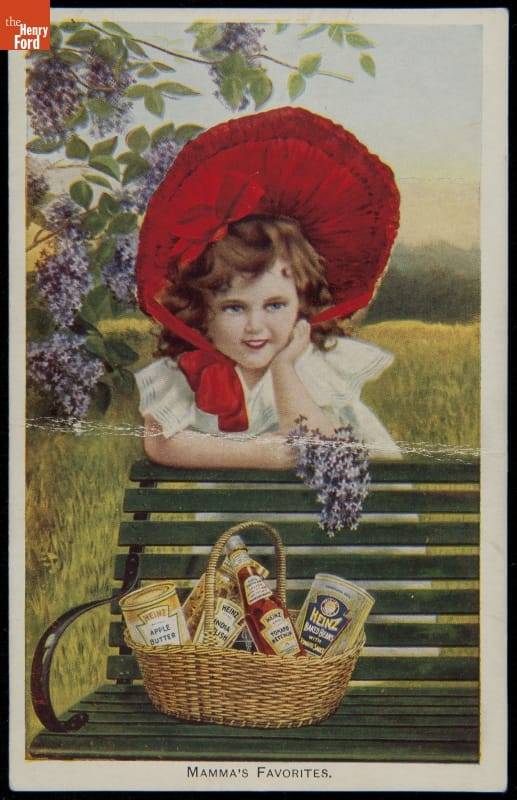
Trade Card for H.J. Heinz Company, “Mama’s Favorites,” circa 1905. THF215296
As consumer demand for peanut butter increased, production increased. Nutritionists understood the value of peanuts and of peanut butter as an inexpensive source of plant-based protein, fats, minerals and vitamins. Farm families could eat their own home-grown peanuts but could also find a ready market for them.

Women grinding peanuts into peanut butter at Heinz. THF292973
Tuskegee, Alabama was located just north of the peanut-growing region of southeastern Alabama. Carver set about to convince Black landowning farmers in and around Tuskegee to take advantage of the market opportunity. Orchestrating a more complete overhaul of cotton-dependent Alabama agriculture required convincing white landowners to free sharecroppers from requirements to grow only cotton. Others sought a revolution in civil rights through legal means. Even though many criticized the self-help message, families who ate better could channel new-found energy toward securing civil rights and social justice.
Carver appealed to his constituents in writing. He linked concerns about health and nutrition to economic independence in his May 1917 pamphlet, “How to Grow the Peanut.”
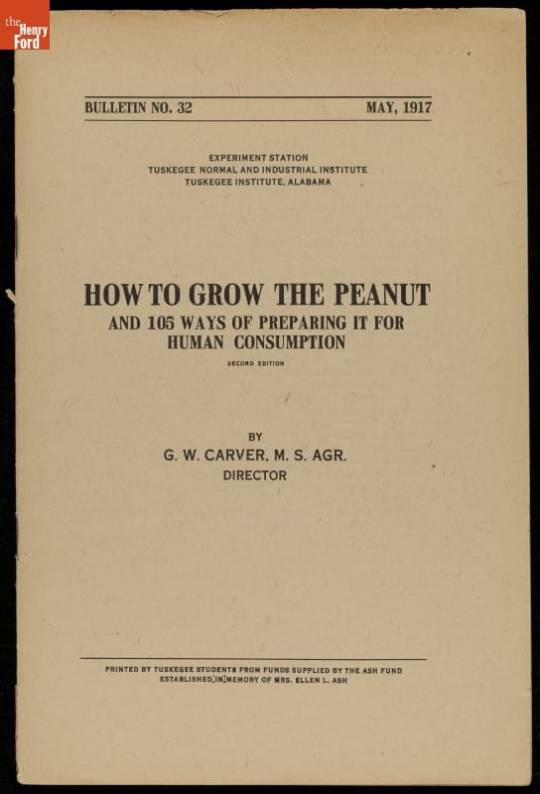
Bulletin, How to Grow the Peanut and 105 Ways of Preparing it for Human Consumption, 1917. THF213329

Carver described the peanut as having “limitless possibilities.” The “nuts possess a wider range of food values than other legumes.” THF213331

Carver described 105 ways to prepare the peanut – ground, boiled, roasted, and as a main ingredient in soups, salads, candy, and replacement for chicken, and other meats. THF213335
Crop Innovations
Carver applied his life-long fascination with plants to identify crops in addition to the peanut that had the potential to displace cotton. He used this weeder to collect specimens. He studied their molecular composition, extracted byproducts, and devised new uses for them.

Weeder Used by George Washington Carver at Greenfield Village, 1942; Gift of Henry and Clara Ford. THF152234.
Carver promoted crops through short publications that stressed financial and food security.
Some crops occurred naturally, the wild plum, for instance, which landowning farmers might have on their property but that they undervalued as a food source.

Bulletin, “43 Ways to Save the Wild Plum Crop,” 1917. THF288049

During World War I, Carver promoted crops that Alabama farmers grew, but that could be processed into alternatives to wheat flour. THF290275
During the 1920s, Carver urged farmers to grow even more crops that they could eat, such as sweet potatoes.

How the Farmer Can Save His Sweet Potatoes, 1925. THF37735
During the 1930s, as economic conditions worsened during the Great Depression, Carver published a pamphlet focused on growing the tomato, a vitamin- and mineral-rich food source.
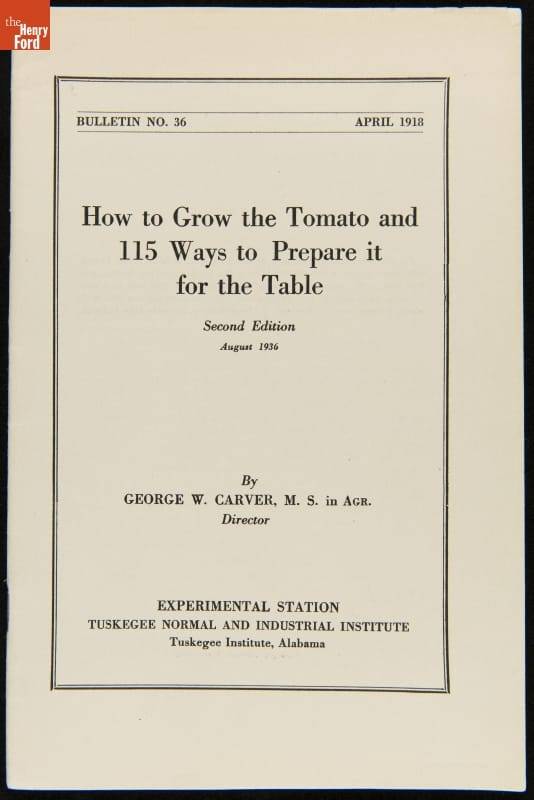
Bulletin, “How to Grow the Tomato and 115 Ways to Prepare it for the Table,” 1936. THF288043
Carver, Food Byproducts, and Food Security
Carver’s research into plant byproducts and new foods from farm crops caught the attention of Henry Ford.
Carver and Clara and Henry Ford corresponded about topics as practical as gravy made from soy and peanut flour, and as personal as digestive systems.

Letter from George Washington Carver to Clara Ford, March 19, 1940. THF213553
Henry Ford recognized Carver’s inspiration by naming the Nutrition Laboratory in his honor on 21 July 1942.

George Washington Carver and Edsel Ford at the Carver Nutrition Laboratory, Dearborn, Michigan, 1942. THF213823
Peanut Oil: A Byproducts Many Uses
Carver explained that peanut oil (separated from peanut paste) was “one of the best-known vegetable oils.” You can see oil, sitting atop the peanut paste, if you look for “natural peanut butter” at your local grocery store. Food chemists experimented with how to prevent the oil from separating from the ground peanut paste. Preventing separation requires hydrogenation, which changes the chemical composition of unsaturated fats and turns them into saturated fats. Heinz drafted advertisements to promote the new hydrogenated peanut butter to consumers as this example indicates.

At Last! No oil on top. THF292249
The varied uses of peanut oil that Carver promoted increased market opportunities for impoverished farmers which increased their food security. To that end, Carver experimented with peanut oil as a rub to relieve the discomfort that polio patients suffered. While science could not link the peanut oil itself to positive benefits, the process of messaging the oil into the patient reduced pain by manipulating the muscles.

Photographic print, Austin Curtis, George Washington Carver, Henry Ford, Wilbur Donaldson and Frank Campsall Inspect Bottles of Peanut Oil, Tuskegee Institute, March 1938. THF213794
Healthy Communities
Building healthy communities started with individuals but grew through collective effort. Farm families, schools, businesses, church groups, and investors each committed resources to the cause. National intervention furthered local goals. The 1946 National School Lunch Act increased access to good food for all school children, not just those who could help themselves.

Photographic Print, Cafeteria at George Washington Carver School, Richmond Hill, Georgia, circa 1947. THF135671
Debra A. Reid is Curator of Agriculture and the Environment at The Henry Ford.
#1 Ford Daily | Đại lý – Showroom ủy quyền Ford Việt Nam 2019 Ford Daily là showroom, đại lý Ford lớn nhất Việt Nam: Chuyên phân phối xe ô tô FORD như: EcoSport ✅ Everest ✅ Explorer ✅ Focus ✅ Ranger… [email protected] 6A Đường Trần Hưng Đạo, Phường Phạm Ngũ Lão, Quận 1, Hồ Chí Minh 711240 0901333373 https://forddaily.com/ https://forddaily.com/xe/ https://forddaily.com/dai-ly/ https://forddaily.com/bang-gia/ https://forddaily.com/tra-gop/ #forddaily #dailyfordhcm #fordshowroomhcm https://www.google.com/maps/place/Ford+Daily/@10.7693359,106.696211,15z/data=!4m5!3m4!1s0x0:0x1f188a05d927f4ff!8m2!3d10.7693359!4d106.696211
0 notes